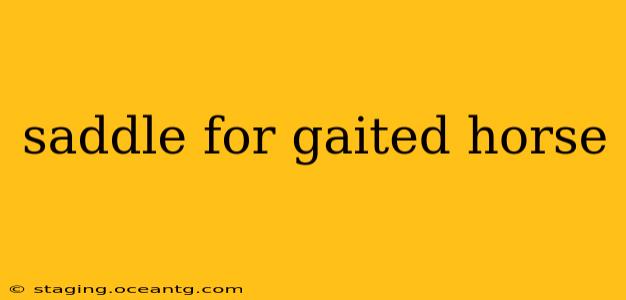Choosing the right saddle for your gaited horse is crucial for both your comfort and your horse's well-being. Gaited horses, with their unique and smooth gaits, require saddles designed to accommodate their specific movement and conformation. This guide will delve into the key considerations when selecting a saddle, addressing common questions and providing expert insights.
What Makes a Saddle Suitable for Gaited Horses?
The primary difference lies in the saddle's design and how it interacts with the horse's movement. Gaited horses often have a slightly different back conformation and movement pattern compared to non-gaited horses. A poorly fitting saddle can restrict their movement, causing discomfort and potentially leading to performance issues. Key features of a good gaited horse saddle include:
- Deep Seat: Provides superior rider stability and security, particularly important during the smooth, flowing gaits of gaited breeds.
- Close Contact: Allows the rider to maintain a close connection with the horse, improving communication and control.
- Flexible Tree: A flexible tree accommodates the horse's back motion, preventing pinching or restriction. This is especially crucial for horses with a more pronounced rocking motion during their gait.
- Wider Gullet: Provides additional clearance for the horse's withers and allows for a better distribution of weight.
What Types of Saddles are Best for Gaited Horses?
Several saddle types are particularly well-suited for gaited horses:
- Trail Saddles: Often feature a deep seat and a wider tree, providing both comfort and stability for longer rides.
- Endurance Saddles: Designed for long-distance riding, these saddles prioritize comfort and weight distribution, making them ideal for gaited horses that may be ridden for extended periods.
- Specialized Gaited Saddles: Some saddle makers create saddles specifically designed for gaited breeds, incorporating features that optimize both rider and horse comfort during the unique gaits.
It's important to note that the best saddle will depend on the specific breed and conformation of your horse, as well as your riding style and preferences.
What are the Different Styles of Gaited Horse Saddles?
Many saddle styles can work well for gaited horses, and the best choice depends on personal preferences and riding discipline. However, some commonly preferred styles include:
- Western saddles: These offer excellent stability and comfort, making them a popular choice for trail riding and longer distances. The wider tree and deep seat suit the gait.
- English saddles: While some English saddles might work, it's crucial to find one with a flexible tree and sufficient clearance for the withers. Certain styles, like the all-purpose saddles, may be more accommodating than others.
Regardless of the type, proper saddle fitting by a professional is essential to ensure the best comfort and performance for your horse.
How Do I Choose the Right Saddle Size and Fit for My Gaited Horse?
Proper saddle fit is paramount. A saddle that's too small can restrict the horse's movement, while one that's too large can slip or cause discomfort. A professional saddle fitter should evaluate your horse's back, withers, and conformation to determine the appropriate saddle size and tree.
- Assess your horse's back: The saddle should fit evenly across the horse's back, avoiding pressure points.
- Check the gullet width: Ensure the gullet provides ample clearance for the withers.
- Observe your horse's reaction: A well-fitting saddle should allow your horse to move freely and comfortably.
What are the Common Issues Associated with Improper Saddle Fit for Gaited Horses?
Incorrect saddle fit can have many negative consequences, including:
- Soreness and discomfort: The most common issue, leading to reluctance to work.
- Back problems: Restricted movement from a poorly fitting saddle can cause significant back problems in the long run.
- Performance issues: Reduced flexibility and discomfort will negatively impact the horse's performance.
- Saddle slippage: An improperly fitted saddle can slip, causing instability and potential injury to both horse and rider.
How Often Should I Check My Gaited Horse's Saddle Fit?
Regular saddle fitting checks are essential. It's recommended to have your saddle professionally checked at least once or twice a year, and more frequently if your horse's condition changes.
This comprehensive guide offers valuable insights into choosing the right saddle for your gaited horse. Remember, a proper fitting and well-suited saddle is key to ensuring both rider comfort and your horse's well-being. Always consult with a professional saddle fitter to ensure the best possible fit for your horse.
